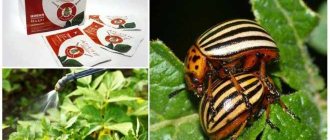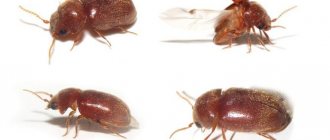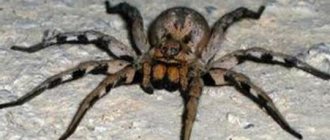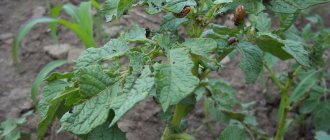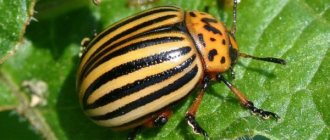This beetle is found in Western Europe, in Russia to the Ural Mountains, and in Central Asia. This is a beautiful, large predatory beetle. The period of its activity occurs in spring and summer; in autumn and winter the insect hibernates. The odorous beetle is listed in the Red Book; its numbers are gradually declining due to the deforestation of broad-leaved forests. The “odorous” beetle gets its name from the stream of smelly liquid that it releases to protect itself from the enemy.
The odorous beetle is a small beetle with bright colors
What are the features of the life cycle
Before turning into a beautiful beetle, the insect goes through a series of transformations. Its life cycle includes the following stages:
- Egg. A female beetle can lay eggs 2-3 times per season. The period of active mating takes place in late spring and early summer. A clutch can contain up to 600 eggs. It all depends on the productivity of the female, weather conditions, and the amount of food supply.
- Larva. After a couple of weeks, large white larvae emerge from the laid eggs. They do not leave the egg shell for some time until they are covered with hard black scutes. After this, the larvae begin active hunting; we can say that they are more aggressive in search of food than their adult relatives and can search for food for themselves day and night. The larva undergoes several molts, and after that it burrows into the ground and pupates.
- Doll. By the end of summer, new cockchafers are formed from the larvae, but they do not leave the cocoon shells and overwinter until next spring. Next year, as soon as it gets warmer and the snow melts, adult young cockchafers will emerge from the pupae.
- Adult insect. An active and voracious predator. One beetle can destroy up to 600 silkworms during the summer. In the fall, at the end of the warm season, the insect burrows into the ground and hibernates, waiting for the next spring.
On average, the lifespan of the beetle beetle is 3-4 years.
How to protect a rare beetle
It would seem that these beetles are well protected by nature itself. But their numbers are gradually decreasing, and at this time the odorous beetle is included in the Red Book as a “species declining in number.”
Red Book
If there is still a lot of it in the mountainous areas, then on the plains the musk beetle has disappeared almost completely.
And only man is to blame for this:
- cuts down forests - the natural habitats of these insects;
- uses pesticides that are harmful to them.
To prevent a decrease in the population, it is necessary to preserve areas of the forest where there are many of these ground beetles and to use biological means of protection against pests. You cannot destroy beetles or catch them for collection.
Conclusion
Nature helps people fight dangerous tree pests by creating an amazing beetle - the fragrant beetle.
Breeding it in your own garden will help protect it from voracious caterpillars, without resorting to chemical protection. Take care of the beauty!
What are some interesting facts?
This beetle is an interesting insect and has been the subject of research and observation by scientists for a long time. Among the most interesting facts regarding the fragrant beetle are:
Read on topic:
Features of the life activity of ladybugs
14.11.2020
Description of chironomids and their possible danger to humans
14.11.2020
What do cutworms look like and what harm do they cause?
14.11.2020
What do goliath beetles look like and can they be bred at home?
14.11.2020
- Attempts to breed this insect in captivity often ended in failure; the beetles did not lay eggs, but simply devoured each other.
The beetles are very beautiful, but dangerous; the bite can cause pain and irritation
- Due to an unsuccessful experiment with breeding gypsy moths in America, there was a sharp increase in the population of this pest. Significant damage was caused to the green foliage of the forests. In order not to use insecticides to treat the forest, a more humane decision was made to import a natural biological predator into the country.
- The beauty larva is twice as long as the adult;
- The coloring of the insect serves as a means of protection and repels potential enemies of birds and small rodents.
- The insect can live a relatively long time for individuals of its species, up to 4 years.
- Despite the attractiveness of the insect, you should be careful with it, it can bite and cause irritation with the poison that it releases from the glands on the abdomen.
- In 1919 in Germany, due to the presence of a large food supply, there was a real dominance of deciduous forests by beetles. As one of the eyewitnesses writes, rustling sounds were heard from all sides, both in the foliage and in the trees - the beetles were hunting for their prey. The forest has definitely come to life.
More about the beauty
Calosoma sycophanta - a large beetle from the ground beetle family can be found south and east of the Southern Urals:
- in Western Asia;
- in the Caucasus and Afghanistan;
- in the mountains of Central Asia and Eastern Kazakhstan;
- in Northwestern China and even North Africa.
It is also widespread in Europe - wherever there are broad-leaved forests. Introduced by humans into North America to combat the uncontrolled spread of silkworms, where it has taken root in the USA and Canada.
By its biological nature, the odorous beetle is an entomophage, feeding on other insects.
Appearance
The fragrant beetle beetle fully justifies its name with its colorful tints on the elytra and other parts of the body:
- the dark blue color of the head and pronotum often has a bluish tint;
- the golden-green wide convex elytra are especially beautiful - they are shiny, with a noticeable reddish metallic tint.
Clearly visible dotted grooves are their additional decoration. Such a bright color is a signal for those who want to feast on it: do not approach.
Appearance of the odorous beauty
To protect itself from enemies, the beetle has special glands located on its abdomen.
They secrete a pungent secretion with a sharp, unpleasant odor that deprives everyone who wants to eat it of appetite. No wonder its other name is musk beetle.
This is the odorous beauty, the description of which would be incomplete without mentioning how well its nature has adapted it to exist in this world full of dangers:
- the elytra completely protect the abdomen;
- powerful mandibles easily hold prey;
- thin, strong limbs allow not only walking, but also running quickly;
- well-protected wings make it possible to fly perfectly;
- long antennae consisting of 11 segments - to navigate in space;
- large bulging eyes make it possible to find prey visually.
And all this is quite large in size - up to 3.5 cm in an adult.
How does an insect live and reproduce?
The odorous beetle leads a diurnal lifestyle. It is most active in the afternoon and late afternoon. The main hunting area is the upper layer of trees.
Beauties sharing the booty
But he prefers to eat food on the ground. If the prey is too large, it can settle in the fork of a tree or on a wide branch.
For an insect, the odorous beetle lives a long time - sometimes up to 4 years. It spends the winter well, hidden in the forest floor.
Sweet beetle on a tree
It wakes up with the onset of warmth and begins its useful activity of exterminating pests.
Throughout its existence, it undergoes a complete metamorphosis:
- egg;
- larva;
- chrysalis;
- imago.
In the spring, a fertilized female lays about 100 eggs if there is little protein food, and up to 600 if there is enough of it. For this important activity, a place is always chosen where there is a lot of food for future offspring.
It only takes a week, or sometimes less, before the larvae appear. They are in no hurry to leave the egg cradle until they acquire a chitinous covering.
Larva of the odorous beautyweed
After this, an active search for food begins, and a lot of it is required - by mid-July the larva should complete its development, moulting twice during this time.
Therefore, it is active day and night. Sometimes the predator does not completely cope with the caught prey, but damages it so much that it dies.
Pupation takes place in the soil - at a depth of up to 30 cm. Already at the end of August or September, adults emerge to the surface, but their first wintering takes place in their pupal cradle.
What does a beetle eat?
Active and large, the fragrant beetle is a beauty, what does the insect eat? Among others, it has another name - large pupal bandit hunter - Calosoma sycophanta L.
The French explorer Fabre called him “the prince among ground beetles” for his ability to find large caterpillars and deal with them. This ruthless predator is not hindered even by the thick hairs covering their bodies.
The fragrant beetle eating a caterpillar
Many insectivorous birds refuse such prey, but the odorous beetle does not. Enzymes from its own saliva help it digest food. He injects it into a killed insect before a meal.
In terms of its feeding pattern, this beetle is an oligophage—its food preferences are quite limited:
- gypsy and ringed silkworms;
- silkworm nun;
- Volyanka;
- leaf roller.
All of them are dangerous pests that cause great damage to forests and gardens. An equally cruel predator is the larva of the musk beetle.
It is larger than the imago, has 3 pairs of legs, perfectly adapted for movement, and jaws with sharp teeth. The larva's field of activity is the top layer of soil and everything on it.
60 caterpillars and 20 pupae - the maximum catch of one larva during the summer season. Adults are much more voracious, and during the same time they destroy up to 300 pests of different species.
What does it eat?
The odorous beetle is an active hunter. Moreover, it can eat not only other insects, but even its own relatives. His diet usually includes:
- caterpillars;
- butterflies;
- small animals.
The beetle usually feeds on caterpillars.
The beetle looks for its prey in the grass, on the ground, in the crowns of trees, and in bushes. There have been cases when the beetle attacked chicks in nests that were not yet covered with feathers. If this predator catches its prey in a tree, then it prefers to go down and continue to eat its prey on the ground.
The beetle processes the prey with special digestive enzymes, its contents soften and become digestible for it.
The odorous beetle is extremely aggressive; if it eats a prey, it knocks its paws, makes noise and can even release a stinking, caustic liquid. If it gets on the mucous surfaces of the body, an allergic reaction may occur and a severe allergic reaction may begin. Therefore, after contact with beetles, you must wash your hands and keep its back part away from you.
Description of the beauty beetle
This is one of the most beautiful representatives of the Coleoptera order. Bright wide and ribbed elytra shimmer, acquiring a blue, green or golden color with a reddish tint.
The head and pronotum are usually dark blue. The size of this beetle varies from 20 to 30 mm. Occasionally larger individuals are also found. This beetle belongs to the category of predators, as evidenced by its powerful jaws, adapted for hunting fairly large butterfly caterpillars.
Describing what the beauty beetle looks like, one cannot help but note its amazing ability to secrete a secretion that has a very pungent odor in case of danger. Thanks to this feature, the beetle received the name “odorous”.
Useful or harmful
The fragrant beetle is a beneficial insect. This is expressed in the fact that no one except him can cope with silkworms and poisonous caterpillars. It inhibits their uncontrolled growth and reproduction. Adult beetles destroy the caterpillars themselves, and its larvae have adapted to destroy silkworm nests from cobwebs.
FROM this video you can learn some interesting facts about these beetles:
In nature, there is no other natural biological “controller” for the growth of the population of harmful caterpillars.
Feeding of the beauty beetle
The favorite food for this insect are caterpillars, which mostly live in the crowns of trees. The beauty beetle seeks out its prey by sight, and not by smell, unlike other ground beetles. He chases her, deftly running along a tree trunk, and then, grabbing her, drags her to the ground, where he kills her and begins to eat. First, the beetle, having filled the caterpillar’s body with its saliva, turns it into a liquid pulp for more convenient absorption. Its powerful jaws, which are clearly visible in the photo of the beauty beetle posted in this article, also help it in this.
Caterpillars and pupae of a wide variety of butterflies are eaten as food, including such serious forest pests as the nun moth, gypsy moth, and corydalis. This predator can also handle very hairy caterpillars, which even insectivorous birds do not eat. It is not for nothing that he is called a comrade of foresters and the winner of the silkworm. In one season, the beauty beetle and its family are capable of destroying up to 6 thousand caterpillars. He also hunts butterflies dozing on the branches of trees, killing them and biting into their abdomen.
In addition, the predator does not disdain completely different food. It happens that the beetle also attacks unfledged chicks sitting in the nest. Its victim may also be any other beetle that gets in the way, even if it is much larger in size.
Benefits of the beauty beetle
This type of insect was used in France as early as 1840 for the purpose of biological control of caterpillars of pest butterflies. To destroy the gypsy moth, it was later brought to America, where it was bred in special insectariums. The beauty beetle is a predator no less useful than the well-known ladybug, which destroys aphids. The large size of the beetle allows it to cope with pests of the appropriate “size”. Living in large numbers in gardens and fields, these predators help people, relieving them of the need to spend effort and money fighting insect pests.
